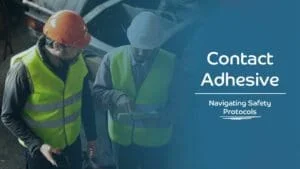Contact Adhesive: Navigating Safety Protocols
Key Takeaways
- Understand Risks: Be aware of VOC emissions, flammability, and skin/eye irritations.
- Safe Workspace: Ensure adequate ventilation, proper adhesive storage, and clear labeling.
- Use PPE: Wear respirators, protective gloves, and safety goggles to minimize exposure.
- Follow Best Practices: Adhere to manufacturer’s instructions, apply adhesively mindfully, and clean spills immediately.
- Emergency Procedures: Respond effectively to skin contact, inhalation, and eye exposure incidents.
- Proper Disposal: Dispose of adhesives and containers according to local hazardous waste regulations.
Introduction
Moving directly into the heart of contact adhesive, safety isn’t just a priority; it’s mandatory. Contact adhesive is more than just creating a robust bond; it’s about ensuring absolute safety in every step. Safety is the foundation of adhesive work, critical for both professionals and DIY warriors.
We’ve already established the versatility of contact adhesive. Now, it’s time to drill down on using this potent adhesive safely. This conversation is centered on recognizing hazards and implementing necessary safety precautions. Mastering safety practices while using contact adhesive is not optional; it’s a must.
Understanding the Risks of Working With Contact Adhesive
Dealing with contact adhesive requires acute awareness of its specific hazards. This adhesive releases Volatile Organic Compounds (VOCs), dangerous in enclosed spaces. Its flammability is a serious fire hazard if mishandled. Direct skin or eye contact can lead to irritation or worse, demanding cautious handling at all times.
Establishing a Safe Workspace
To handle contact adhesive safely, your workspace must be well-ventilated. Good ventilation helps eliminate harmful fumes and minimizes inhalation risks. Store adhesives securely and far from heat sources to avert fires. Label all adhesive containers clearly to avoid misuse and confusion.
Personal Protective Equipment (PPE)
Proper protective gear is non-negotiable. Respirators or masks are vital for filtering harmful fumes, especially in poorly ventilated areas. Protective gloves are indispensable to prevent skin contact and irritation, while safety goggles are crucial for protecting your eyes against any splashes.
Contact Adhesive Handling and Application Best Practices
Adhere strictly to the manufacturer’s guidelines for safe application and handling. Control your adhesive application to avoid accidental spills and splatters. Immediately clean up any spills, ensuring your skin is fully protected during cleanup.
Emergency Response Procedures
In an emergency, your response must be swift and informed. If contact adhesive gets on your skin, wash it off immediately with soap and water. For stubborn adhesive, carefully use a recommended solvent and seek medical help for serious reactions. Experience symptoms like dizziness or breathing trouble from inhalation? Move to fresh air and get medical assistance if symptoms continue. For eye exposure, rinse gently yet thoroughly and seek immediate medical care.
Disposal and Environmental Considerations
Dispose of contact adhesive and its containers the right way. Follow your local hazardous waste management rules; don’t just toss them in regular trash or down drains. Think about the environmental impact and choose adhesives with lower VOC levels when you can. Look into recycling and safe reuse options for any containers or leftover material.
Creating a Culture of Safety
Foster a safety-first mentality in every aspect of adhesive use. Implement regular safety training and awareness initiatives to hammer home the critical nature of safety protocols. Make safety a top priority in every project. Lead by example and keep channels open for discussions on safety issues and enhancements.
Conclusion
Emphasizing safety with contact adhesive isn’t just recommended, it’s an obligation to your own safety and that of your peers. Grasping and applying safety procedures, being ready for emergencies, and responsibly disposing of materials guarantee a secure and effective use of this potent adhesive.
In our upcoming discussion, we’ll delve into the environmental ramifications of contact adhesive. We’ll offer insights on making ecologically sound choices in your endeavors. For tailored needs, expert guidance, or a custom quote, head over to Forza Built. Our crew is on standby to help you navigate your project ambitions with safety and sustainability at the forefront.
FAQ
Q: What are the main risks associated with using contact cement and adhesive?
A: The primary risks involved in using contact cement and adhesive include the emission of Volatile Organic Compounds (VOCs), which can be harmful if inhaled in enclosed spaces. Many of these adhesives also possess flammability risks, making them a fire hazard if not handled properly. Direct contact with these substances can lead to skin and eye irritations. Understanding these risks is crucial for ensuring safe use.
Q: How can I create a safe workspace for using these adhesives?
A: To ensure a safe workspace, it is vital to maintain adequate ventilation. This helps disperse harmful fumes and reduces the risk of inhalation. Store adhesives away from heat sources and ensure they are securely placed to prevent accidental spills. Clearly label all containers to avoid misuse. A well-organized and clearly marked workspace contributes significantly to safety.
Q: What Personal Protective Equipment is necessary for safely handling these adhesives?
A: The essential PPE for safely handling contact cement and adhesive includes respirators or masks, which are crucial for filtering out harmful fumes, especially in less ventilated spaces. Protective gloves are necessary to prevent skin contact, which can lead to irritation or burns. Safety goggles are also important for protecting your eyes against accidental splashes.
Q: What are the best practices for handling and applying contact cement and adhesive?
A: Key practices include reading and following the manufacturer’s instructions carefully for both safety and application. Apply adhesives in a controlled manner to avoid spills and splatters, and clean up any accidental spills immediately while ensuring your skin is protected. Mindful application and immediate response to spills are crucial for safety.
Q: What should I do in case of an emergency while using contact cement or adhesive?
A: In case of skin contact, wash the area immediately with soap and water, and use a recommended solvent cautiously for stubborn adhesive. If you experience respiratory discomfort due to inhalation, move to an area with fresh air and seek medical attention if symptoms persist. For eye exposure, rinse gently but thoroughly with water and seek immediate medical attention after rinsing.
Q: How should I dispose of adhesives and consider their environmental impact?
A: Dispose of adhesives and their containers in accordance with local hazardous waste management regulations. Avoid disposing of them in regular trash or down drains. Be mindful of the environmental footprint of adhesives by opting for products with lower VOC content and considering eco-friendly alternatives. Explore recycling or repurposing options for containers and leftover materials.
Q: How can I foster a culture of safety when using adhesives?
A: Cultivating a culture of safety involves regular training and awareness sessions to reinforce the importance of safety protocols. Always prioritize safety, whether on a professional job site or a personal DIY project, and lead by example. Encourage open communication about safety concerns and improvements, and share experiences and insights to prevent accidents.



